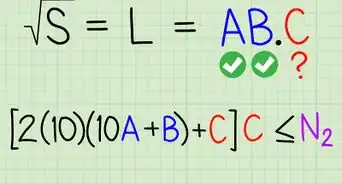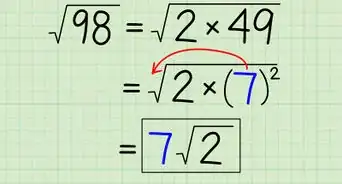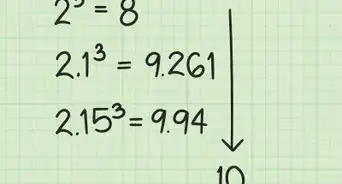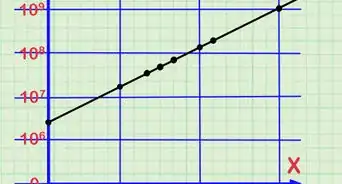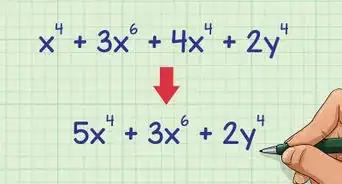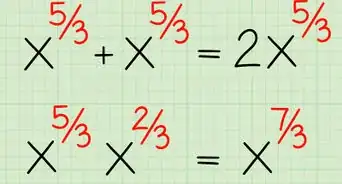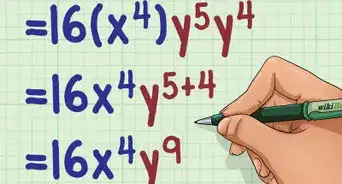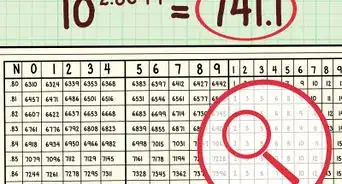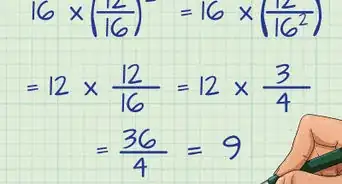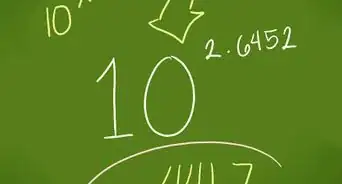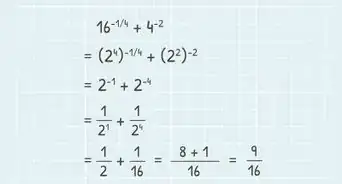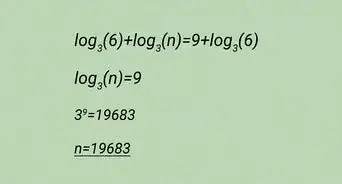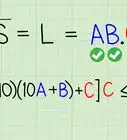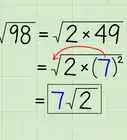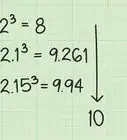This article was co-authored by David Jia. David Jia is an Academic Tutor and the Founder of LA Math Tutoring, a private tutoring company based in Los Angeles, California. With over 10 years of teaching experience, David works with students of all ages and grades in various subjects, as well as college admissions counseling and test preparation for the SAT, ACT, ISEE, and more. After attaining a perfect 800 math score and a 690 English score on the SAT, David was awarded the Dickinson Scholarship from the University of Miami, where he graduated with a Bachelor’s degree in Business Administration. Additionally, David has worked as an instructor for online videos for textbook companies such as Larson Texts, Big Ideas Learning, and Big Ideas Math.
There are 7 references cited in this article, which can be found at the bottom of the page.
This article has been viewed 608,774 times.
Calculating square root is easy if you have a perfect square. If you don’t, there’s a logical process you can follow to systematically figure out the square root of any number, even if you don’t use a calculator. You will need to understand basic multiplication, addition, and division first, though.[1]
Steps
Finding the Square Root of Perfect Squares
-
1Figure out the perfect square root using multiplication. The number’s square root is a number that, when multiplied by itself, equals the first number.[2] Another way of saying this is: “What can we multiply by itself to get the number in question?”
- For example, the square root of 1 is 1 because 1 multiplied by 1 equals 1 (1X1=1). However, the square root of 4 is 2 because 2 multiplied by 2 equals 4 (2X2=4). Think of the square root concept by imagining a tree. A tree grows from an acorn. Thus, it’s bigger than but related to the acorn, which was at its root. In the above example, 4 is the tree, and 2 is the acorn.
- Thus, the square root of 9 is 3 (3X3=9), of 16 is 4 (4X4=16), of 25 is 5 (5X5=25), of 36 is 6 (6X6=36), of 49 is 7 (7X7=49), or 64 is 8 (8X8=64), of 81 is 9 (9X9=81), and of 100 is 10 (10X10=100).[3]
-
2Use division to find the square root. To find the square root of a whole number, you could also divide the whole number by numbers until you get an answer that is the same as the number you used to divide the whole number.
- For example: 16 divided by 4 is 4. And 4 divided by 2 is 2, and so on. Thus, in those examples, 4 is the square root of 16, and 2 is the square root of 4.
- Perfect square roots do not have fractions or decimals because they involve whole numbers.
Advertisement -
3Use the right symbols for square root. Mathematicians use a special symbol called the radical to indicate square root. It looks like a check mark with a line across the top going to the right.[4]
- N equals the number whose square root you are trying to find. It goes inside the check mark symbol.[5]
- Thus, if you are trying to find the square root of 9, you should write a formula that puts the "N" (9) inside the check mark symbol (the "radical") and then present an equal sign and the 3. This means the “square root of 9 equals 3.”
Finding the Square Root of Other Numbers
-
1Take a guess at it, and use the process of elimination. It's tougher to figure out square roots of numbers that are not whole. But it's possible.
- Let’s say you want to find the square root of 20. You know that 16 is a perfect square with a square root of 4 (4X4=16). Similarly, 25 has a square root of 5 (5X5=25), so the square root of 20 must fall in between 4 and 5.
- You could guess that 20’s square root is 4.5. Now, simply square 4.5 to check your guess. That means you multiply it by itself: 4.5X4.5. See if the answer is above or below 20. If the guess seems off, simply try another guess (maybe 4.6 or 4.4) and refine your guess until you hit 20.[6]
- For example, 4.5X4.5 = 20.25, so logically you should try a smaller number, probably 4.4. 4.4X4.4 = 19.36. Thus, the square root of 20 must lie in between 4.5 and 4.4. How about 4.445X4.445. That’s 19.758. It’s closer. If you keep trying different numbers using this process, you will eventually get to 4.475X4.475 = 20.03. Rounding off, that’s 20.
-
2Use a process of averaging. This process also starts with you trying to find the closest whole numbers that your number falls in between.[7]
- Then, divide your number by one of those square root numbers. Take the answer, and find the average of it and the number you divided by (average is just the sum of those two numbers divided by two). Then take the original number and divide it by the average you got. Finally, find the average of that answer with the first average you got.
- Sound complicated? It can be easiest to follow an example. For example, 10 lies in between the 2 perfect square numbers of 9 (3X3=9) and 16 (4X4=16). The square roots of those numbers are 3 and 4. So, divide 10 by the first number, 3. You will get 3.33. Now, average the 3 and 3.33 by adding them together and dividing them by 2. You will get 3.1667. Now take 10 divided by 3.1667. The answer is 3.1579. Now, average 3.1579 and 3.1667 by adding them together and dividing the sum you get by two. You will get 3.1623.
- Check your work by multiplying your answer (in this case 3.1623) by itself. Indeed, 3.1623 multiplied by 3.1623 equals 10.001.
Community Q&A
-
QuestionIf I have a building that is 40 x 60 feet, how do you find out if it is square?
 DonaganTop AnswererThere are two ways to do it: (1) If you can measure the inside diagonals (from a corner to its opposite corner), the diagonals of a perfect rectangle are equal to each other; (2) Get a magnetic compass and sight it along two adjacent sides. The two directions should be exactly 90° from each other.
DonaganTop AnswererThere are two ways to do it: (1) If you can measure the inside diagonals (from a corner to its opposite corner), the diagonals of a perfect rectangle are equal to each other; (2) Get a magnetic compass and sight it along two adjacent sides. The two directions should be exactly 90° from each other. -
QuestionHow do I calculate the square root without a calculator?
 Community AnswerUse a factor tree. For example, 625 = 5 x 125 = 5 x 5 x 25 = 5 x 5 x 5 x 5. Because there are 4 fives, and we are looking for the square root, (5 x 5)(5 x 5) = 625. Therefore the square root of 625 is 25.
Community AnswerUse a factor tree. For example, 625 = 5 x 125 = 5 x 5 x 25 = 5 x 5 x 5 x 5. Because there are 4 fives, and we are looking for the square root, (5 x 5)(5 x 5) = 625. Therefore the square root of 625 is 25. -
QuestionWhat is the smallest four-digit whole number divisible by 9 that has two even and two odd digits?
 Community AnswerThe number 1089 is the answer. The way you work it out is 1008 is a 9 time table number. Then just add on nines starting at this number, and the first 9 times table number you get that has two even digits and odd digits is your answer.
Community AnswerThe number 1089 is the answer. The way you work it out is 1008 is a 9 time table number. Then just add on nines starting at this number, and the first 9 times table number you get that has two even digits and odd digits is your answer.
References
- ↑ https://sciencing.com/calculate-square-root-hand-5081134.html
- ↑ https://www.geeksforgeeks.org/how-to-find-square-roots-without-a-calculator/
- ↑ http://www.math.com/school/subject1/lessons/S1U1L9DP.html
- ↑ https://www.mathsisfun.com/square-root.html
- ↑ https://www.sangakoo.com/en/unit/elements-of-a-square-root-and-calculation-step-by-step
- ↑ http://www.homeschoolmath.net/teaching/square-root-algorithm.php
- ↑ http://www.factmonster.com/ipka/A0932229.html
About This Article
To find a square root of a number without a calculator, see if you can get to that whole number by squaring smaller numbers, or multiplying a smaller number by itself. If the number is a perfect square, you will get a whole number as the square root. Otherwise, try squaring numbers with a decimal until you get as close as possible to your original number. If you want to learn how to estimate the square root of imperfect squares, keep reading the article!





